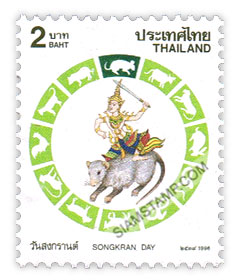| Details :
|
Songkran Day - the Ancient Thai New Year
Songkran is a Sanskrit word meaning passing or moving into, specifically referring to the passage of the sun into a particular sign of the zodiac. A sign refers to a particular group of stars, ther being a total of twelve zodiac signs. It takes approximately on monrth for the the sun to move in and out of a particular sign and when twelve signs have passed, a year is completed. Thi one year is called a "nakasat" year, (nakasat years refer to cycle of 12 years, called 12 nakasats). Images of different types of animals are used to represent particular signs for each of the years, namely:
- The year of the rat :
a rat and a male angel.
- The year of the ox :
a cow and a male human being.
- The year of the tiger :
a tiger and a female human being.
- The year of the rabbit :
a rabbit and a female being.
- The year of the great snake :
the Naga king and a male angel.
- The year of the snake :
a small snake and a male human being.
- The year of the horse :
a horse and a female angel.
- The year of the goat :
a goat and a female angel.
- The year of the monkey :
a monkey and a male butterfly.
- The year of the rooster :
a rooster and a male butterfly.
- The year of the dog :
a dog and a female butterfly.
- The year of the pig :
a pig and female human being.
Songkran Day of B.E. 2539 (1996) coincides with the year of the rat, its nakasat sign depicting a male angel seated atop a rat. The next year, B.E. 2540 (1997), being the year of th ox will have as its nakasat sign, a male human being seated atop an ox, and the cycle continues until its completetion in the twelfth nakasat sign and henceforth a new cycle
resumes with the year of the rat.
|





